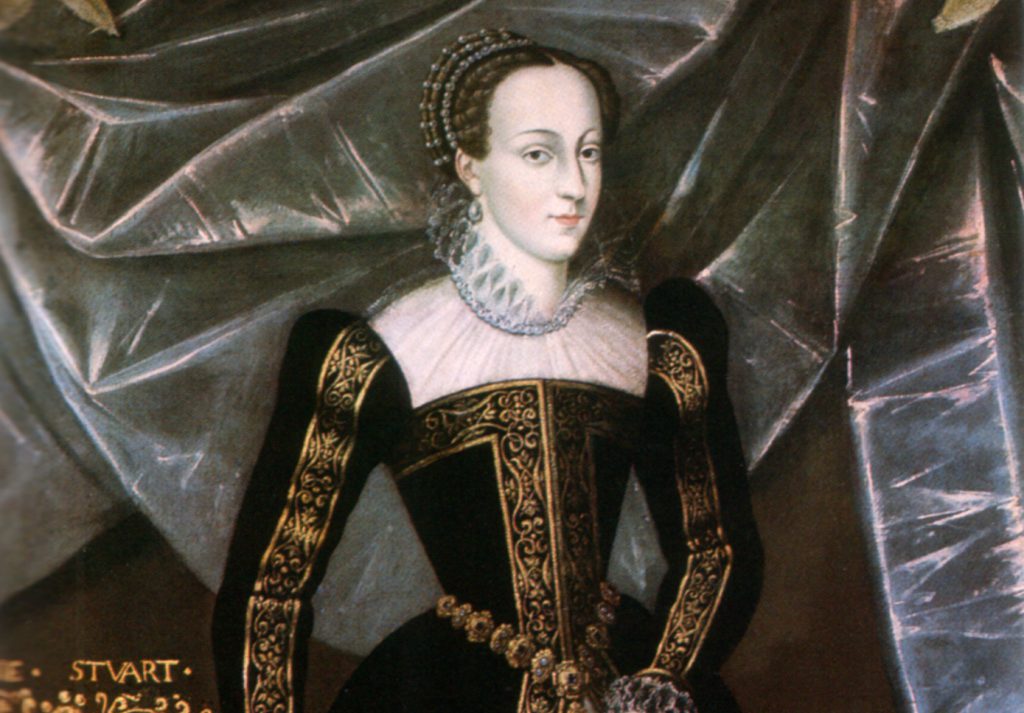Have you ever wanted something so bad you would do anything to get it? What if that goal was a crown and a whole kingdom? What would you do? Would your actions be worth it in the end if you did something that could potentially ruin your life, or even end it? Sometimes our ambitions make us act recklessly in order to achieve our goal. And in the end the results could be disastrous. As the song from the Rolling Stones says, “you can’t always get what you want,” and that is what Mary Stuart, Queen of Scotland learned the hard way when she fought for the English throne, and in the end, lost her life.
Mary Stuart was born on December 7, 1542 to King James V of Scotland and Mary of Guise1 She was the only living child of King James V, so she became the heir to the throne, and then Queen shortly after her birth, when her father died. As the granddaughter of Margaret Tudor, sister to Henry Tudor VIII King of England, she was next in line for the English throne. Because of her ties to the throne of England, she was often pushed to become the Queen of both Scotland and England.
In her attempt to become the next heir to the English throne after her cousin Elizabeth, Mary decided to wed someone who would strengthen her claim to the throne. This was a danger to Queen Elizabeth’s reign, because the people Mary considered to be a potential husband made Mary’s claim even stronger, because she would then have a husband, where Elizabeth did not. In order to gain Queen Elizabeth’s favor, Mary had considered marrying someone that Elizabeth chose for her, but when Elizabeth suggested Lord Dudley for her, the favored Earl of Leicester, Mary decided against it. Instead, she married her cousin, Henry Stuart, or Lord Darnley, who also had a claim to the English throne through his grandmother Margaret Tudor.2
This led to a rebellion in Scotland because Protestants believed that the marriage of Mary to Lord Darnley would bring Catholicism back to Scotland and England because their claim to the English throne was stronger. The rebellion was led by Mary’s half-brother James Stuart, but was defeated by Mary. This was the start of her growing unpopularity in Scotland.3 When she first met Lord Darnley, she had thought that he was charming, and quickly arranged for their marriage. But after they married, she found that his attitude was completely different. Her marriage quickly became unhappy. Lord Darnley was a drunkard and was a jealous, stubborn, immature man. Because of his immaturity, Queen Mary refused to give him the crown matrimonial, which would have allowed him to rule Scotland, and this angered him.
Mary started avoiding him, and eventually she started spending a great amount of time with some of her advisers and secretaries, particularly David Riccio. Riccio was her secretary for French correspondence, and he quickly gained influence with the Queen and her policies.4 The amount of time Queen Mary spent with Riccio created rumors that she was having an affair with the secretary and that the baby she was carrying belong to Riccio. A group confronted Lord Darnley and put this rumor in his ear. This, combined with jealousy, infuriated Lord Darnley, who created a plot to kill Riccio. In 1566, Lord Darnley, along with the group, surprised the Queen, Riccio, and a countess at dinner, and dragged Riccio out of the room and stabbed him repeatedly, killing him.5 It is also argued that Mary also could have been a target, but there is no clear evidence.
After this event Mary never forgave Lord Darnley, and their relationship became even more strained. Their son, James, who would become James I of England, was born in June 1566, and his birth did nothing to improve their relationship.6 Mary made sure that Lord Darnley would never forget what he had done, by making comments such as the ones she made when their son was born: “My Lord, God has given you and me a son, begotten by none but you. Here I protest to God as I shall answer to him… that this is your son and no other man’s son.”7 Mary would continue to push Lord Darnley away and would completely leave him out of meetings. She decided that his presence was no longer needed, and she began looking for a way to annul their marriage. Out of fear for her son’s claim to the throne, Mary was hesitant to get an annulment.

In the meantime, the Queen met and befriended another councilor, James Hepburn, the Lord Bothwell. It was also believed that the Queen was having an affair with Lord Bothwell. On February 10, 1567, Lord Darnley was killed.8 It appeared that Lord Darnley was killed when the house he was staying at had exploded, but it was later discovered that he was killed somewhere else entirely and by suffocation. Automatically, the suspicion fell on Lord Bothwell, and it is speculated that Mary also had a role in the murder.9 There is evidence that could possibly connect Mary to helping Lord Bothwell plot the death of her husband, known as the Casket Letters, but there is still not enough evidence. To this day it is still unknown whether the Queen of Scotland had a role in Lord Darnley’s murder. The rumors of an affair between Queen Mary and Lord Bothwell became stronger when she refused to convict Lord Bothwell, and he was subsequently acquitted of all charges, despite the advice of Queen Elizabeth and her former mother-in-law, Catherine Medici of France.10
Shortly after, Mary and Lord Bothwell married, which to many only confirmed the rumors. Mary claimed that Lord Bothwell abducted, raped, and forced her into the marriage.11 Like her last marriage, she was not happy. She appeared to regret marrying Lord Bothwell and seemed depressed, listless, and would often talk of suicide. Her marriage was the last straw for what little supporters she had left, and a civil war broke out in Scotland. By June, the Earl of Moray had an army to fight Queen Mary and Lord Bothwell under the banner of the murdered Lord Darnley and their son James.12 The rebels believed that Mary was no longer fit to rule because of the marriage. When she was captured at Carberry Hill, she was given the choice to keep the throne if she gave up Lord Bothwell. When she refused the offer, even her own army began to desert her. Lord Bothwell was able to escape, but the Queen was captured and taken prisoner to Edinburgh.13 On July 24, Mary was forced to abdicate the throne to her son James, and his regency would be given to the Earl of Moray.
Mary escaped Scotland to England shortly after, and begged her cousin, Queen Elizabeth, for sanctuary. Queen Elizabeth’s advisers warned her against it, because they thought she was a threat, but Queen Elizabeth allowed her to stay. While in England, Mary was under investigation again for the murder of her husband Lord Darnley, and due to the lack of evidence, she was not convicted. While in England, she was kept almost like a prisoner, under house arrest for the next eighteen years, without being able to contact her son, the now King of Scotland.14 She would spend most of her time knitting, but that was not all she was doing.

Some of Queen Elizabeth’s advisers had been keeping an eye on Mary, and they discovered three plots against Queen Elizabeth that would seal Mary’s fate. The first plot, known as the Ridolfi plot, was a conspiracy with Thomas Howard and King Philip of Spain, to assassinate Queen Elizabeth and make Mary Queen of England.15 Letters discussing the plot were intercepted by one of Queen Elizabeth’s advisers and the plot was foiled. The Queen’s advisers pushed her to punish Mary, but she refused because the evidence was not certain. In the end, Howard was executed and Mary remained a prisoner. The second plot was called the Throckmorton plot. In this the French were to invade England and assassinate Queen Elizabeth. From this, Parliament created an act for the Queen’s safety. In this act, if the Queen was killed, any party responsible would be tried and executed.16 In the final plot, Mary was caught in the act by an undercover agent who found the letters that incriminated Mary Stuart. Queen Elizabeth’s advisers strongly pushed for her to sign Mary’s death warrant, but she hesitated because she did not want the controversy of executing a queen. In the end, she reluctantly signed the warrant and on February 8, 1587, Mary was beheaded without the Queen’s knowledge.17
From the beginning, Mary Stuart had wanted the English throne and she made decisions that she thought would make her a better candidate for that throne. She thought the best way to gain the crown was through marriage, but in the end you could argue that that was the beginning of her downfall. You could say she most certainly did not get what she wanted.

- Elizabethan World Reference Library, 2007, s.v. “Stuart, Mary.” ↵
- Elizabethan World Reference Library, 2007, s.v. “Stuart, Mary. ↵
- Elizabethan World Reference Library, 2007, s.v. “Stuart, Mary.” ↵
- Women in World History: A Biographical Encyclopedia, 2002, s.v. “Mary Stuart (1542-1587),” by Kimberly Estep Spangler. ↵
- Women in World History: A Biographical Encyclopedia, 2002, s.v. “Mary Stuart (1542-1587),” by Kimberly Estep Spangler. ↵
- Women in World History: A Biographical Encyclopedia, 2002, s.v. “Mary Stuart (1542-1587),” by Kimberly Estep Spangler. ↵
- Women in World History: A Biographical Encyclopedia, 2002, s.v. “Mary Stuart (1542-1587),” by Kimberly Estep Spangler. ↵
- Encyclopedia of World Biography, 2004, s.v. “Mary Queen of Scots.” ↵
- Encyclopedia of World Biography, 2004, s.v. “Mary Queen of Scots.” ↵
- Encyclopedia of World Biography, 2004, s.v. “Mary Queen of Scots.” ↵
- Women in World History: A Biographical Encyclopedia, 2002, s.v. “Mary Stuart (1542-1587),” by Kimberly Estep Spangler. ↵
- Women in World History: A Biographical Encyclopedia, 2002, s.v. “Mary Stuart (1542-1587),” by Kimberly Estep Spangler. ↵
- Women in World History: A Biographical Encyclopedia, 2002, s.v. “Mary Stuart (1542-1587),” by Kimberly Estep Spangler. ↵
- Encyclopedia of World Biography, 2004, s.v. “Mary Queen of Scots.” ↵
- Elizabethan World Reference Library, 2007, s.v. “Stuart, Mary.” ↵
- Elizabethan World Reference Library, 2007, s.v. “Stuart, Mary.” ↵
- Elizabethan World Reference Library, 2007, s.v. “Stuart, Mary.” ↵



52 comments
Amelia Hew
For the Queen of Scotland, her life was kind of a tragedy with her father died when she was still a baby and was often pressured to become queen of not only Scotland but also England. When she was older, she could’ve become a queen fit for the throne but her choice of marriage hindered her path to success and also her greed of wanting to have both countries under her rule even going as far to start a rebellion to take the English throne after her downfall in Scotland. True, she does not have a happy ending but at least her story will be remembered for many years to come.
Chelsea Alvarez
Congratulations on your nomination! I had no prior knowledge of who Mary Queen of Scots was, so it was really interesting reading this article. The introduction itself captivated me to wanting to know who this woman was and what she did. All of her hardships show just how much of a resilient woman she was. It is unfortunate that she did not get the ending she wanted.
Maria Martinez
This was a great article, I heard of Mary Queen of Scots after the release of the movie based on her story but I never really looked into her life. As an author you did a great job of explaining as much of her life as possible while keeping the story easy enough to follow. I do not know much about the time period in which this occurred but I do know that women were not considered as capable as men, especially when it came to ruling so for her to have done all that the article explained is an interesting thought. Congratulations on the nomination!
Victoria Salazar
Wow, this was a lot to take in. I am not sure how I feel about Mary. I do not think she wanted the crown for the right reasons, but at the same time she’s not the first. Although, the reason why I pointed it out is because she was so far from the crown but made it her whole life’s goal to get it one way or another. I think it was smart of her to not give the crown matrimonial since Lord Danley was a drunkard and an immature man. I don’t think a lot of her cards were played right, but it was a great article to read.
Alicia Guzman
This article highlights one of the most well known contentious fights for the throne. While I think ambition is very admirable, there comes a point where one can become greedy and that is definitely the point Mary Queen of Scots got. It got to the point that everything in her life became some sort of a zero-sum game – one, that is not healthy and two, it led to her demise so I guess that says all that needs to be said. Congratulations on your nomination!
Sharriah Martinez
Thank you for this great read! Congrats on your nomination it was well deserved. I had never heard of Mary Queen of Scots. Her life was actually very tragic. The legends are very interesting too. It was crazy that they believe he died because he found out he was having a girl, that blows my mind. She too had a very poor choice in men.
Auroara-Juhl Nikkels
I knew some about Mary of Scots becuase of my European History class in high school. Your article allowed the reader to see exactly what unchecked ambition could cause: ultimately failure and possibly death. Furthermore, she never really lived happily. Happiness should be a goal of ours, rather than power and ambition.
Mariah Cavanaugh
Mary’s ambition and determination were admirable and necessary for any woman who wanted to succeed at the time. Your article gave a great overview of Mary’s life, but I think it was too broad and offered a surface level overview of her life. I would be interested to read more in dept stories about Mary’s many relationships and her fall from grace.
Sarah Uhlig
I really liked Mary Queen of Scots story about her life. I first learned about her through the recent film released about her that was in theatres last year. It was so horrible all that had happened to her and how she was murdered by Queen Elizabeth for treason, but this article well describes her life and I really enjoyed it. She was a powerful and remarkable woman. Congratulations on your article being nominated for the ceremony.
Maya Mani
Great article! Given the circumstances, and all of the hardships Mary had to endure during her earlier years and throughout, I feel terrible for what happened to her. She became devoted and sought no other options but to continue on with her plan. There are many stories both in real life and in movies/novels, where the character undergoes such tragic events, and unfortunately does not have a happy ending.